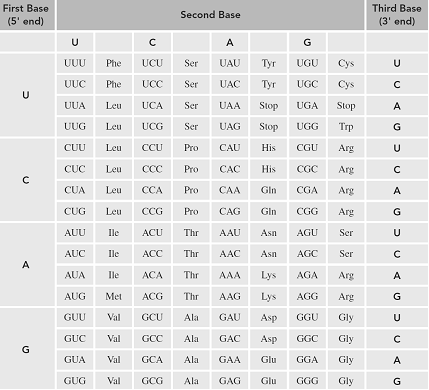
Concept explainers
Interpretation:
The base, codon, anticodon and the amino acid needed to complete a given table needs to be stated.
Concept Introduction:
The first step of the synthesis of proteins using the information in DNA is transcription.
During transcription, the synthesis of messenger RNA (mRNA) from DNA takes place.
Only one DNA strand is needed for RNA synthesis, thus the double helix of DNA unwinds during transcription. The strand used for the RNA synthesis is called template strand. The other strand (the non-template strand) is called informational strand and does not involve in the RNA synthesis.The informational strand of DNA is complementary to the template strand.
The informational strand of DNA is complementary to the template strand; meaning the base sequence of the informational strand consists of the complementary base sequence of the template strand.
complementary base pairs:
Adenine pairs with thymine (A−T base pair).
Cytosine pairs with guanine (C−G base pair).
In addition, the direction of the two strands in the same DNA have different directions. Therefore, if the template strand goes from 3' to 5', the informational strand goes from 5' to 3'.
The mRNA synthesized from transcription has a complementary sequence to the DNA template from which it is prepared. Since the informational strand of DNA is complementary to the template strand, the mRNA is an exact copy of the informational strand, the only exception is that the base T present in the informational strand is replaced by U on the RNA strand.
The information needed to prepare a polypeptide is in the mRNA strand. Each sequence of three
The below table gives the corresponding amino acid of each codon. Based on the codon sequence of the mRNA strand, the amino acid sequence of the polypeptide strand can be determined with the help of the table.

Transfer RNA (tRNA) brings specific amino acids to add to the synthesizing peptide chain. Each individual tRNA contains an anticodon of three nucleotides that is complementary to the codon in mRNA.
Want to see the full answer?
Check out a sample textbook solution
Chapter 22 Solutions
CONNECT IA GENERAL ORGANIC&BIO CHEMISTRY
- Nonearrow_forward3. A molecular form of "dicarbon", C2, can be generated in gas phase. Its bond dissociation energy has been determined at 599 kJ/mol. Use molecular orbital theory to explain why energy of dissociation for C₂+ is 513 kJ/mol, and that for C2² is 818 kJ/mol. (10 points)arrow_forward9.73 g of lead(IV) chloride contains enough Cl- ions to make ____ g of magnesium chloride.arrow_forward
- 6. a) C2's. Phosphorus pentafluoride PF5 belongs to D3h symmetry group. Draw the structure of the molecule, identify principal axis of rotation and perpendicular (4 points) b) assume that the principal axis of rotation is aligned with z axis, assign symmetry labels (such as a1, b2, etc.) to the following atomic orbitals of the P atom. (character table for this group is included in the Supplemental material). 3s 3pz (6 points) 3dz²arrow_forward2. Construct Lewis-dot structures, and draw VESPR models for the ions listed below. a) SiF5 (4 points) b) IOF4 (4 points)arrow_forward5. Complex anion [AuCl2]¯ belongs to Doh symmetry point group. What is the shape of this ion? (4 points)arrow_forward
- 4. Assign the following molecules to proper point groups: Pyridine N 1,3,5-triazine N Narrow_forward7. a) Under normal conditions (room temperature & atmospheric pressure) potassium assumes bcc lattice. Atomic radius for 12-coordinate K atom is listed as 235 pm. What is the radius of potassium atom under normal conditions? (3 points) b) Titanium metal crystallyzes in hcp lattice. Under proper conditions nitrogen can be absorbed into the lattice of titanium resulting in an alloy of stoichiometry TiNo.2. Is this compound likely to be a substitutional or an interstitial alloy? (Radius of Ti (12-coordinate) is 147 pm; radius of N atom is 75 pm. (3 points)arrow_forwardcan someone answer the questions and draw out the complete mechanismarrow_forward
 Chemistry for Today: General, Organic, and Bioche...ChemistryISBN:9781305960060Author:Spencer L. Seager, Michael R. Slabaugh, Maren S. HansenPublisher:Cengage Learning
Chemistry for Today: General, Organic, and Bioche...ChemistryISBN:9781305960060Author:Spencer L. Seager, Michael R. Slabaugh, Maren S. HansenPublisher:Cengage Learning General, Organic, and Biological ChemistryChemistryISBN:9781285853918Author:H. Stephen StokerPublisher:Cengage Learning
General, Organic, and Biological ChemistryChemistryISBN:9781285853918Author:H. Stephen StokerPublisher:Cengage Learning Organic And Biological ChemistryChemistryISBN:9781305081079Author:STOKER, H. Stephen (howard Stephen)Publisher:Cengage Learning,
Organic And Biological ChemistryChemistryISBN:9781305081079Author:STOKER, H. Stephen (howard Stephen)Publisher:Cengage Learning,- Chemistry: Matter and ChangeChemistryISBN:9780078746376Author:Dinah Zike, Laurel Dingrando, Nicholas Hainen, Cheryl WistromPublisher:Glencoe/McGraw-Hill School Pub Co
 Principles of Modern ChemistryChemistryISBN:9781305079113Author:David W. Oxtoby, H. Pat Gillis, Laurie J. ButlerPublisher:Cengage Learning
Principles of Modern ChemistryChemistryISBN:9781305079113Author:David W. Oxtoby, H. Pat Gillis, Laurie J. ButlerPublisher:Cengage Learning Chemistry: Principles and PracticeChemistryISBN:9780534420123Author:Daniel L. Reger, Scott R. Goode, David W. Ball, Edward MercerPublisher:Cengage Learning
Chemistry: Principles and PracticeChemistryISBN:9780534420123Author:Daniel L. Reger, Scott R. Goode, David W. Ball, Edward MercerPublisher:Cengage Learning





